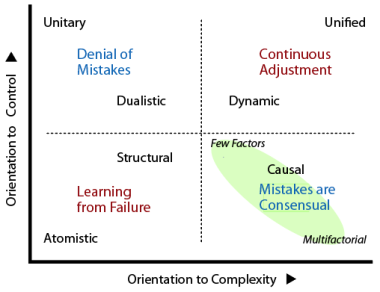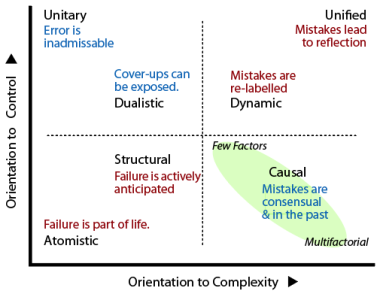Handling Failures and Mistakes
Change is difficult. The future is unknown. Corruption and criminality apart, honest mistakes can be made. But this avoids the issue. The differing thinking styles appear to encourage or even generate failure. As a result, handling failure differs markedly according to the quadrant.
UL Quadrant: Denial of Mistakes
paradigms view admission of error as a risk to collapse of the imposed depiction. That is why dictatorial regimes end up creating serious failures and disasters. Pervasive corruption and use of lies to curry favor with superiors maintains the illusion or delusion of total control. When mistakes occur, they are covered up and denied. Blame is assigned to external forces. Reviews whitewash the authorities, and those involved in the mistake may be imprisoned or killed to prevent information reaching the public. Whistleblowers who attempt to warn and protect others are typically imprisoned or killed.

theorists ignore their errors. Dualism in governing regimes also leads to denial but usually in the form of hiding mistakes. Mechanisms like official reviews, auditors, and often the press can potentially bring failures to light. Because politicians routinely deny, lie, shift blame and use their powers to cover up the truth, it can take years, even decades, for the facts to emerge. Exposure is typically because of serious harm and even death to large numbers of people e.g. the contaminated blood scandal![]() in the UK, the robodebt scandal
in the UK, the robodebt scandal![]() in Australia.
in Australia.
In most countries, politicians are the least trusted group in society: trusted in the UK for example, by under 10% of the population in the 2023 survey. This appears to be an intelligent judgement. However, the reasons for the persistence of socially-destructive behaviour are many and include:
• Expectations of infallibility i.e. caused by immaturity of the electorate.
• Fear of loss of support i.e. the electorate could lose trust and vote accordingly.
• Access to levers of power i.e. it is simple, quick, easy and expedient for those in power to deny, falsify, lie etc.
• Narrative control i.e. social stability depends on public perceptions and these can be shaped by propaganda and narratives.
• Cultural pressures i.e. society often deems errors as embarrassing and conventions require politicians to fabricate.
• Policy implications i.e. pursuit of a difficult but necessary policy will be impeded by the unvarnished truth.
• Personal egoism i.e. unwillingness of elite leaders to accept imperfection and lose self-esteem.
• Exploitation by opponents i.e. admitted errors are likely to be highlighted, exaggerated, criticized and publicized.
Because simplistic thinking and polarization of public opinion are a recipe for an endless stream of mistakes, it is hard to see how improvement within a dualistic system is possible.
LL Quadrant: Learning from Failure
adherents regard mistakes as part of living and see denial of failure as a personal problem. They view initiative as essential and failures as inevitable. It is actually hard to learn from success and much easier to learn from failure. By continuously generating initiatives and learning from failures and mistakes, experience and confidence develops leading to ultimate success.
depictions generate rule-based frameworks where error is diagnosable and rectifiable by adjusting the configuration or functions. So entities, like organisations, appreciate that mistakes are common, that failure can always occur. As this may entail costly repair or even cause a collapse, monitoring and evaluative systems are instituted. Reviews are held regularly to look for emerging problems and ensure remediation is not excessively delayed or avoided.

LR Quadrant: Mistakes are in the Past
thinking results in a consensus around a prediction based on relations between a few key factors. But if that relation is not as simple as presented, then choice based on it will likely lead to problems, potentially serious. When that relation turns out to be misconceived due to confounding factors, inappropriate assumptions, incomplete information or some other scientific error, no blame is apportioned and no redress is applied. Instead, a new rationalization is developed.
UR Quadrant: Continuous Adjustment is Preventive
systems are characterized by continuous monitoring and feedback because it is assumed that decisions will need to be revised or even reversed and a course of action may need re-shaping as events unfold. Unlike other quadrants, unsatisfactory choices tend to be labeled as unsuitable or inappropriate rather than as mistakes or failures if they made sense at the time. Continuous reflection and adjustment to changing conditions is used to avoid serious mistakes.
Thinking in general, and failures particularly, contribute to personal identity formation and maintenance. Group views and pressures can either form member identity or be formed by the people involved.
- Consider how affect identity management.
Originally posted: 30-Jun-2024. Last amended: 15-July-2025.